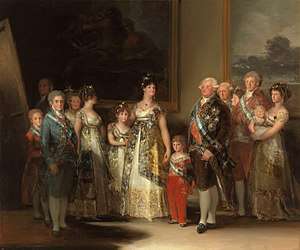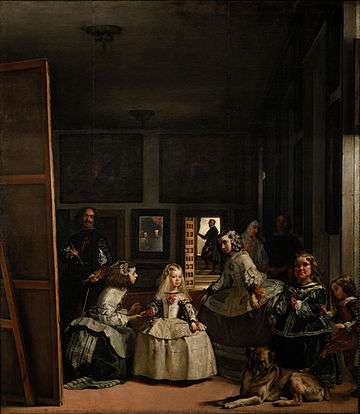Charles IV of Spain and His Family
Charles IV of Spain and His Family is an oil on canvas painting by the Spanish artist Francisco Goya. He began work on this painting in 1800, shortly after he became First Chamber Painter to the royal family, and completed it in the summer of 1801.
| Charles IV of Spain and His Family | |
|---|---|
| Spanish: La familia de Carlos IV | |
 | |
| Artist | Francisco Goya |
| Year | 1800-1801 |
| Medium | Oil on canvas |
| Dimensions | 280 cm × 336 cm (110 in × 132 in) |
| Location | Museo del Prado, Madrid |
The portrait features life-sized depictions of Charles IV of Spain and his family, ostentatiously dressed in fine costume and jewelry. Foremost in the painting are Charles IV and his wife, Maria Luisa of Parma, who are surrounded by their children and relatives. The family are dressed in the height of contemporary fashionable clothing, and lavishly adorned with jewelry and the sashes of the order of Charles III.[1]
The painting was modeled after Louis-Michel van Loo's 1743 Portrait of Felipe V and his Family and Velázquez's Las Meninas, setting the royal subjects in similarly a naturalistic and plausible setting[2] as they pose for the artist who is visible at his easel at the left of the canvas. Unlike these earlier depictions which sought to flatter their subjects, Goya's group portrait is unflinchingly realist, sometimes grotesquely so, both in detail and tone.
Description

The group portrait was completed the year after Goya became first court painter, the highest position available to a Spanish artist, and one previously occupied by Diego Velázquez.
Goya did not say why he chose to model the work after the older master; the notion of a tradition of Spanish painting did not exist at the time . Perhaps Goya was motivated by the troubled times; the painting having been completed some eleven years after the French Revolution, when the Spain was still dealing with its implications and aftermath, which lead to Napoleon's invasion of Spain and his 1808 placing of his brother on the Spanish throne.[3]
The royal family is apparently paying a visit to the artist's studio, while Goya can be seen to the left looking outwards towards the viewer.[4] Goya seems to focus his attention on three figures: Charles IV, who is dressed in blue, his wife, Maria Luisa of Parma, standing center, and their son Ferdinand. Although a formal portrait, there are indications of intimacy between the family members; Queen Maria Luisa holds the hand of the youngest child. In contrast to the Velázquez, the painting does not show any of the royal family's servants or attendants. More importantly, Goya omits narrative structure; it is simply a painting of people posing for a painting.[3]
As in Las Meninas, the artist is shown working on a canvas, of which only the rear is visible; however, the atmospheric and warm perspective of the palace interior of Velázquez's work is replaced in the Goya by a sense of, in the words of Gassier, "imminent suffocation" as the royal family are presented by Goya on a "stage facing the public, while in the shadow of the wings the painter, with a grim smile, points and says: 'Look at them and judge for yourself!'"[4]
Sitters
.jpg)
The barely visible man in the background shadows at the left is Goya himself[5] (2). Others are, left to right:
- (1) Carlos Maria Isidro (1788–1855) – King's 2nd son
- (3) the future Fernando VII (1784–1833) – King's 1st son
- (4) Maria Josefa (1744–1801) – King's sister
- (5) Maria Antonia of Naples – it was not known whom she would be by the time the work was created
- (6) María Isabel (1789–1848) – King's daughter
- (7) Maria Luisa of Parma (1751–1819) – King's wife
- (8) Francisco de Paula (1794–1865) – King's youngest son
- (9) Charles IV (1748–1819) – King
- (10) Don Antonio Pascual (1755–1817) – King's brother
- (11) Carlota Joaquina (1775–1830, only part of head visible) – King's eldest daughter
- (12) Don Luis de Parma (1773–1803) – King's son-in-law
- (13) their baby Carlos Luis (1799–1883), the future Duke of Parma[6]
- (14) his wife Maria Luisa (1782–1824) – King's daughter, holding
Interpretation
The French writer Theophile Gautier called it a 'picture of the corner grocer who has just won the lottery' and it has sometimes been believed that Goya was in some way satirising his subjects. The idea has been dismissed however by the art critic Robert Hughes: "This is nonsense. You didn't manage to keep your job as an official court portraitist if you were satirising the people you were painting. No, this is not a send up. If anything it is an act of flattery. For instance on the left, in the blue suit, is one of the most odious little toads in the entire history of Spanish politics, the future King Ferdinand VII, whom Goya actually manages to make quite regal. God knows how he did it, but he has. This is very much an act of respect, almost verging on an act of flattery."[7]
Notes
- "The Family of Carlos IV". Museo del Prado. Retrieved 23 July 2018
- Gassier (1995), 69–73
- Tomlinson, p. 150
- Gassier (1989), 66
- De la Croix, Horst; Tansey, Richard G.; Kirkpatrick, Diane (1991). Gardner's Art Through the Ages (9th ed.). Thomson/Wadsworth. p. 887. ISBN 0-15-503769-2.
- Edward J. Olszewski – Exorcising Goya's "The Family of Charles IV" Archived 2012-12-24 at the Wayback Machine
- Goya, Crazy like a Genius, An Oxford Film and Television Production for BBC and RM associates
Sources
- Buchholz, Elke Linda. Francisco de Goya. Cologne: Könemann, 1999. ISBN 3-8290-2930-6
- Davies, Denny, Hofrichter, Jacobs, Roberts, Simon. Janson's History of Art. Prentice Hall, London, 2011. 824–825. ISBN 0-205-68517-X
- Gassier, Pierre. Goya. Rizzoli International Publications, 1989. ISBN 0-8478-1108-5
- Gassier, Pierre. Goya: Biographical and Critical Study. New York: Skira, 1995. 69–73
- Tomlinson, Janis. From El Greco to Goya: Painting in Spain from 1561-1828. Laurence King, 2012. ISBN 978-1-7806-7028-7